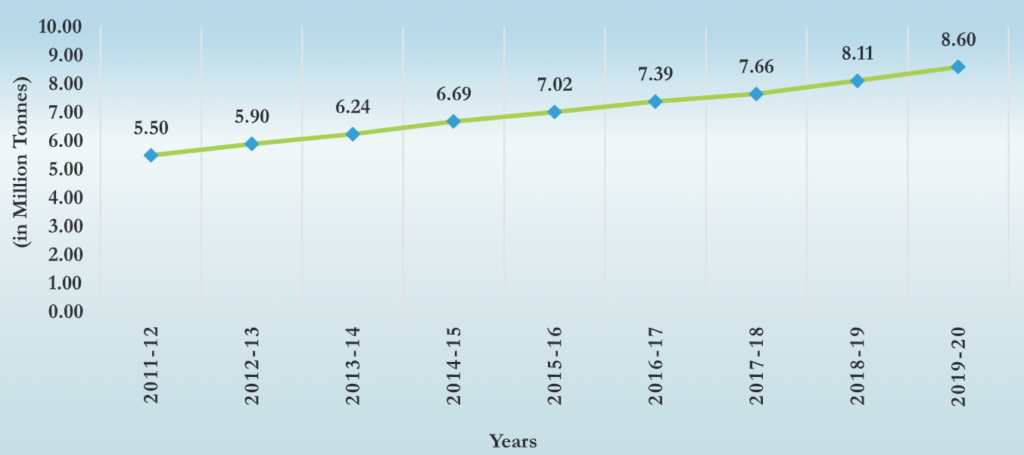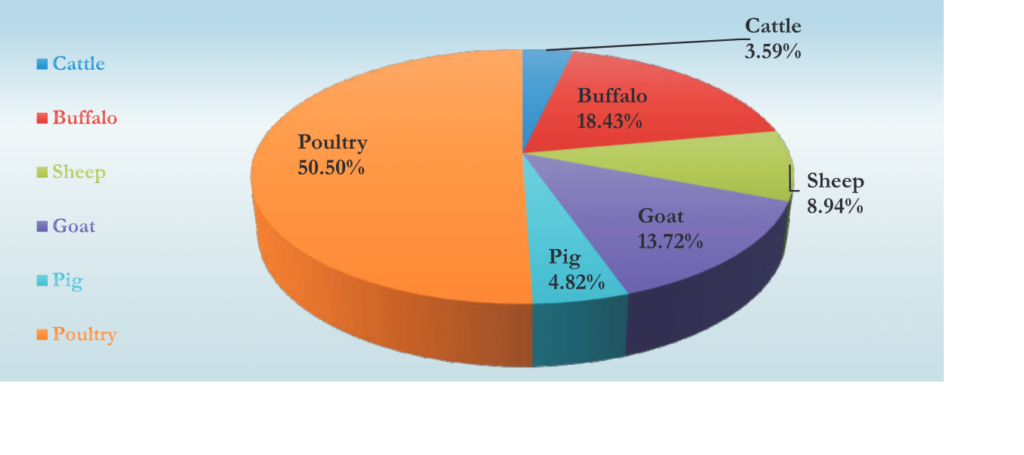The livestock population of any country is a deciding factor for its meat production potential besides societal barriers, traditions, customs and preferences of its natives. Thus, the sustainability of the livestock sector is a decisive factor in the sustainability of the meat industry. As far as India is concerned, it is bestowed with a huge livestock population (Table 1) that plays a pivotal role in the Indian economy. The cattle and buffalo population of India is about 13% and 42.61% of the global population, respectively sharing more than 50% collectively of the total world population that are generally reared in rural areas by small, marginal, or landless labourers. The large ruminants are mostly reared for milk production, though after their full utilization of dairy life, mainly buffaloes are meant for meat production. However, their utilization as draught animals have gone down due to progressive mechanization. The small animals (ruminants and non-ruminants) like sheep, goats and pigs are reared mainly for meat production. The other products obtained from sheep and goats are fiber/wool and milk.
Table 1: Livestock population in India as per 20th Livestock Census (Source: BAHS, 2020)
| Species | Population (Million Numbers) 2012 | Population (Million Numbers) 2019 |
| Cattle | 190.90 | 192.52 |
| Buffalo | 108.70 | 109.85 |
| Total bovines | 299.6 | 302.3 |
| Sheep | 65.07 | 74.26 |
| Goat | 135.17 | 148.88 |
| Horses and ponies | 0.63 | 0.34 |
| Camels | 0.40 | 0.25 |
| Pig | 10.29 | 9.06 |
| Mules | 0.20 | 0.08 |
| Donkeys | 0.32 | 0.12 |
| Yak | 0.08 | 0.06 |
| Mithun | 0.3 | 0.4 |
| Total Livestock | 512.06 | 535.82 |
| Poultry* | 729.21 | 851.81 |
*Poultry includes chicken, ducks, turkey and other birds
As per the latest report of basic animal husbandry statistics, the livestock population has shown an increase of 4.82% from 2012 to 2019 and among different species of livestock, sheep showed a maximum increase (14.13%) followed by goats (10.14%), cattle (1.34%) and buffalo (1.06%). However, a major decline was observed in pigs (-12.03%). The % share of India and the ranks India holds in terms of different species’ population on global front have been illustrated in table 2 along with the names of the state that tops in the species population.
Table 2: Status of the Indian livestock sector on the global front
| Species | % Present in India | Rank | Top producer state |
| Total Livestock | 10.59 | 1st | |
| Cattle | 12.5 | 2nd | West Bengal |
| Buffalo | 56.7 | 1st | Uttar Pradesh |
| Sheep | 5.6 | 3rd | Rajasthan |
| Goat | 13.34 | 2nd | Rajasthan |
| Pig | 1.33 | – | Assam |
Meat production in India
In terms of total meat production, India ranks 5th globally with the production of 8.60 million tonnes of meat in 2019-20. In 2020-21, meat production has increased to 8.80 million tonnes (BAHS, 2021). The Indian meat industry has exhibited steady growth in terms of meat production in the last decade as illustrated in figure 1. However, the annual growth rate has not been seen following any particular trend. The annual growth rate of Indian meat production in 2019-20 was estimated as 5.98% which was 5.99% in 2018-19. The contribution of different states to the total Indian meat production varies depending upon the livestock population. Uttar Pradesh was the top meat producing state in the country in 2019-20, producing 13.56% of total meat production in the country, followed by Maharashtra (13.26%) and West Bengal (10.50%).

The contribution of different species to total meat production has been exhibited in figure 2 which indicates the highest contribution of buffalo meat among different livestock species followed by goat, sheep, pig and cattle. Half of the total meat production is contributed by poultry alone. However, the meat availability in India is only about 15g/person/day against the ICMR recommendation of 30g/person/day and per capita, world meat consumption is 43kg/annually. Per capita meat availability in India in 2019-20 was 6.45kg/annum. India’s meat consumption is very low – currently 4.5 kg per capita – and it has grown by only 1 kg in the last 20 years.

Concerned meat polices
Slaughter and processing: The slaughter and processing of animals for domestic use is regulated by the Food Safety and Standards Authority of India (FSSAI) employing the Food Safety and Standards Rules and Regulation (2011).
Export: Agricultural and Processed Food Products Export Development Authority (APEDA) of India regulates the export of meat. APEDA is an apex body that promotes India’s export trade in food and agricultural products (including fresh fruits and vegetables, processed food products, livestock products, and cereals). It is an agency of the Ministry of Commerce and Industry. Only that meat from India can be exported which has been produced and processed in the APEDA registered abattoirs and meat processing plants and that too after compulsory microbiological and other testing. A regular animal health checkup by the respected state veterinary officer is mandatory for which the establishment submits an online request to the respective state animal husbandry office. The veterinary officer issues the animal health certificates to the registered processing establishment after a proper checkup. India exports primarily frozen (halal) boneless carabeef, which is typically thawed, and resold in wet markets. India ranks first in terms of buffalo meat export. About 111 modern meat plants have been registered with APEDA having HACCP and ISO 22,000 certification (APEDA, 2020)
Import: An importer must first obtain an import license from the Director-General of Foreign Trade (DGFT). The import request is reviewed and approved by the Ministry of Fisheries, Animal Husbandry and Dairying/Department of Animal Husbandry and Dairying after conducting the risk analysis. The import of livestock products is governed by an “open general license” (OGL). The import of meat is regulated under Section 3 and Section 3A provisions of the Livestock Importation Act, 1898 by Department of Animal Husbandry and Dairying to prevent the entry of exotic diseases. Recently, DAHD has come up with a new regulation for imported products that implies the occasional inspection of products by Animal Quarantine and Certification Services (AQCS) officials.
Trade: Trade of meat is regulated by the Ministry of Commerce and Industry (MOCI) of India along with the trade of other livestock and livestock products trade.
Steps initiated to boost the growth of livestock sector
As per recent report published in 2021, various schemes offered by the Department of Animal Husbandry and Dairying have recently been merged into three broad categories as Development Programs, Livestock Health and Disease Control and Infrastructure Development Fund. (Mani et al., 2021). A special package of approx. $1.32 billion for livestock sectors has been released over the five years from 2021 to 2026. The schemes that got merged under these categories include:
- Development Programs: Rashtriya Gokul Mission, National Program for Dairy Development, National Livestock Mission and Livestock Census and Integrated Sample Survey as sub-schemes
- Livestock Health and Disease Control: Livestock and Disease Control Scheme and National Animal Disease Control Program
- Infrastructure Development Fund: the funds of animal husbandry and dairy infrastructure fund have been merged
Further, FMD is the most critical disease for India to manage to boost meat export for which India has a World Organization for Animal Health (OIE)-endorsed official program (initiated in May 2015) for controlling the disease. Recently in 2019, India’s Union Cabinet has approved a new scheme in the National Animal Disease Control Program (NADCP) to eradicate the foot-and-mouth disease and brucellosis outbreaks by 2030. Through this program, the entire susceptible population of bovines, as well as small ruminants and pigs are required to vaccinate at a six-month interval.
Conclusion
India, being bestowed with a huge livestock population, has great potential to sustain a viable meat industry. Further, many steps have been taken along the same lines to boost the industry. The organized broiler industry, where animals would be grown specifically for meat purposes is the speculated future of India.
Gauri Jairath1*, Devi Gopinath1, Ajayta Rialch1, Putan Singh1, Sudesh Radotra2 and Suman Bishnoi3
1ICAR-Indian Veterinary Research Institute, Regional Station, Palampur-176061
2ICAR-Indian Grassland and Fodder Research Institute, Regional Station, Palampur-176061
3Lala Lajpat Rai University of Veterinary and Animal Sciences-125001